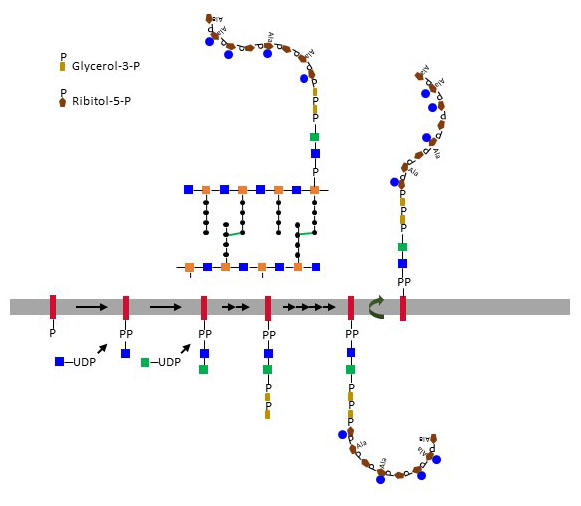Teichoic acid
The cell wall of Gram-positive bacteria contain teichoic acids, which are anionic glycoconjugates contributing to the stability and permeability of the cell surface. Teichoic acids come either as lipo-teichoic acid anchored in the cell membrane, or wall teichoic acid, which are covalently bound to the peptidoglycan network. Both types of teichoic acid extend through the peptidoglycan layers and provide points of anchor for extracellular and cell wall proteins. The biosynthesis of teichoic acid follows the same pattern as colonic acid and peptidoglycan biosynthesis with initiation and elongation on a polyprenol carrier at the cytoplasmic side of the plasma membrane. GlcNAc-P is first transferred to undecaprenol-P from UDP-GlcNAc, yielding undecaprenol-PP-GlcNAc. This reaction is analogous to the formation of dolichol-PP-GlcNAc formation in eukaryotes, which initiates N-linked glycosylation. Remarkably, tunicamycin also inhibits this first step of teichoic acid biosynthesis. Elongation proceeds on undecaprenol-PP by addition of a ManNAc residue followed by about 50 units of glycerol-P or ribitol-P.
Figure X. Biosynthesis of teichoic acid. Some bacterial strains (e.g. Bacillus subtilis 168) only synthesize glycerol polymers. The glycosylation of ribitol varies greatly between bacterial stains. Glc usually decorates ribitol in Bacillus subtilis and GlcNAc in Staphylococcus aureus.
Whereas the main function of teichoic acids is to ensure structural rigidity by attracting cations to the cell wall, the glycoconjugate also contributes to the adhesion of bacteria to biological surfaces. For example, the adhesion of Staphylococcus aureus to epithelial cells require teichoic acid. The functional significance of the Glc and GlcNAc on teichoic acid chains are still unclear. Teichoic acids, like peptidoglycan, activate innate immunity through binding to the TLR2/CD14 complex.
